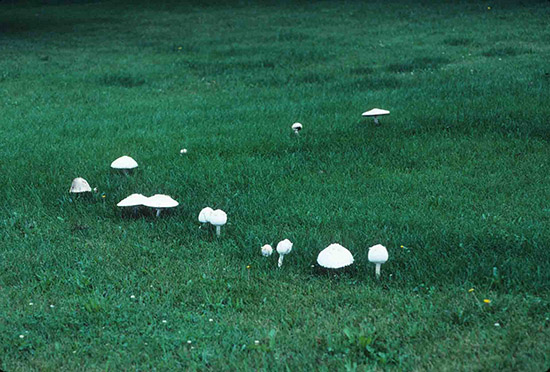Issue 10, June 27, 2016
Mushrooms in the Turf
Mushrooms can suddenly pop up in lawns throughout the summer, often appearing overnight. Typically, most of the mushrooms are more annoying than problematic, though on occasion, they can indicate some underlying turfgrass issues.
Mushrooms come in many shapes, sizes and colors. More importantly, they are the fruit bodies of the fungi living in the turf or underlying soil. As such, they really aren't causing problems but merely housing the spores for reproduction. Removing the mushroom does little more than improve the appearance of the lawn, though it does keep the mushrooms away from animals and children. Fungal spore production may be reduced in the immediate vicinity, but spores can be carried in breezes for many miles, as well as by animals. Most mushrooms aren't toxic, but there are some lawn mushrooms that could be. It's a safe practice to NOT eat any of the mushrooms without a 100% positive identification.
There is really no way to predict where most mushrooms will appear and at what time of the year. Typically, mushrooms appear after prolonged wetness either through rain or irrigation. Some mushrooms, such as those causing fairy rings, are a little more predictable.
Mushroom producing fungi feed on organic matter in the soil, which could be anything from thatch between the soil and green grass, decaying tree roots, or lumber left over and buried in the lawn during home construction. Most of these fungi feed on this organic matter, breaking it down and recycling nutrients for other plants. It's essentially nature's "Circle of Life." In most cases, once the organic matter has been decayed, the mushrooms will disappear.
Some mushrooms appear in newly laid sod, often around new home construction where building material has been buried. Since the sod is kept moist for a week or two until it's rooted, the excess moisture is perfect for mushroom production. Only wetting the sod and the top two inches of soil until the roots establish may cut down on mushroom production.
Fairy ring mushrooms usually pop up in a circle or an arc, and are usually accompanied by a dark green circle or crescent of grass. If the turf is lifted, a white mycelial mat can usually be found that could be several inches thick. Several genera including Marasmiuss, Chlorophyllum, and Agaricus cause fairy rings.

Mushroom fairy ring.
Stinkhorns look like an extended finger or phallus when mature. In fact, the genus of the mushroom is Phallus. The mushrooms cap is usually covered with a sticky goo that stinks, but attracts insects which carry the spores to another location.
Inky caps (Coprinus) have that traditional mushroom look, but with caps that turn dark black and slimy when mature. Puff balls (Vascellum), usually show up later in the season, and look like snowy white globes when young, ranging in size from a few inches to 18 inches.
Other mushrooms popping up in the yard include Armillaria (usually around the base of dead or dying trees), Clitocybe, Conocybe (often depicted in non-morel mushroom lawn ornaments) and Panaeolus spp.
Aesthetic control involves removing the mushrooms as soon as they appear. They can easily be broken or kicked over, gathered and discarded in the trash or buried in the compost pile.
Check the thatch. If excessive (more than ½") thatch is present, dethatch in the early autumn or spring, as well as determine why the thatch accumulation is present. Aeration will control thatch and allow water to penetrate into the root zone to stimulate grass growth.
With new construction, make sure wood products are not buried in the yard but discarded properly.
If mushrooms keep reappearing, fertilizing could hasten the decomposition of organic matter. Use water-soluble fertilizers at the rate of no more than 1 pound actual nitrogen per 1000 square feet in the early fall (September), and late spring (May). (David Robson)
Author:
David Robson